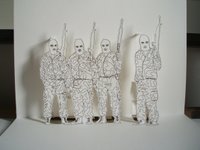p2p

p2p
curated by Marketta Seppälä/Veronica Wiman
EPA, Erhardtstr. 27, 80469 Munich
Jasper Sebastian Stürup (DK)
Joachim Koester (DK)
Kathrine Aertebjerg (DK)
Veli Granö (FI)
Jari Silomäki (FI)
Tellervo Kalleinen (FI)
Anu Tuominen (FI)
Jacob Dahlgren (SE)
Frida Fjelllman (SE)
Uglycute (SE)
Hale Tenger (TR)
KUTU (TR)
Ahmet Ögüt (TR)
In today's information society, economic, technological and social systems are undergoing rapid change, altering the meaning of local time and geographical space. The transformation is especially challenging with regard to the ethical foundations of the information society. The commodification of innovation has become an increasingly important goal of the global information economy. What, however, is to become of the Utopia of openness, where ideas and innovations are freely accessible and everyone has the same opportunities to create and share information?
The brief history of the internet shows how innovations of the information society are invented several times over. The World Wide Web, which came into being through the creative combination of existing technologies and was made freely available, has brought millions of people together in the 15 years of its existence. Tim Bernes-Lee, the technology's "inventor", once said that if he had asked even one cent of each person using the Web, it would never have become generally accessible.
Many people now find it hard to imagine life without the internet. The net is a tool for transmitting information, it is the world largest and most effective network for commercial transactions, and it also plays a crucial role in providing a meeting point for peers, friends and people with shared interests. A quick search can immediately involve the user in a dialogue or the development of a common interest with others all over the world – regardless of geographical location. The connection offers an intimacy between people that in better times leads to generous and mutually beneficial exchanges.
One of the consequences of the internet has been the emergence of open source software, as a challenger to proprietary software. This began almost by accident, in 1991, when Linus Torvalds uploaded a piece of source code onto the net – purely for amusement – which later became known as the Linux operating system.
Open source was, until recently, confined to specific interest communities and business areas. Today, however, there are practitioners in every field, with usage growing especially in music and the visual arts. By creating alternative modes of expression as well as new and different forms of ownership, open source acts as a kind of alternative business model vis-à-vis the existing paradigms, based on competitiveness.
Which models will dominate in the future, we can only wait and see. Today, open source software would seem to be opening the way to the information society for the poor, developing countries. However, its future remains an open question: the basic idea of open source code is old, dating back at least to the origins of writing, but open source has perhaps never been as "open" as one might wish.
The history of Europe has been a history of aggressively defined borders and exclusions, within which people and ethnic groups have positioned themselves in terms of "them" and "us". An important dimension of art now is to explore and analyse these contexts, and thereby find ways of facilitating the development of shared identities that would displace old suspicions and grievances. Art, by its very nature, has always been a communication of new ideas and inventions. Throughout history, and in our own time, the most creative insights often are the product of coincidence, combining existing inventions or even "abusing" technologies.
Like p2p, which relies on its participants to share within the network, the artistic landscape shown here is robust and powerful, relying on collaboration between many variations. Rather than looking for "essences"– of Danishness, Turkishness, Swedishness, Finnishness, etc. – the selection of works has focused on forms of personal expression which provide evidence of the specific elements that form the context of each nation's or continent's identity. Our aim is to foster a collaborative environment in which many individual voices and practices converge and become unified, in a broader understanding of the development of contemporary culture – and of humanity at large.
Marketta Seppälä / Veronica Wiman
http://epart.epo.org/exhibition/check-in/concept/p2p/index.en.php


<< Home